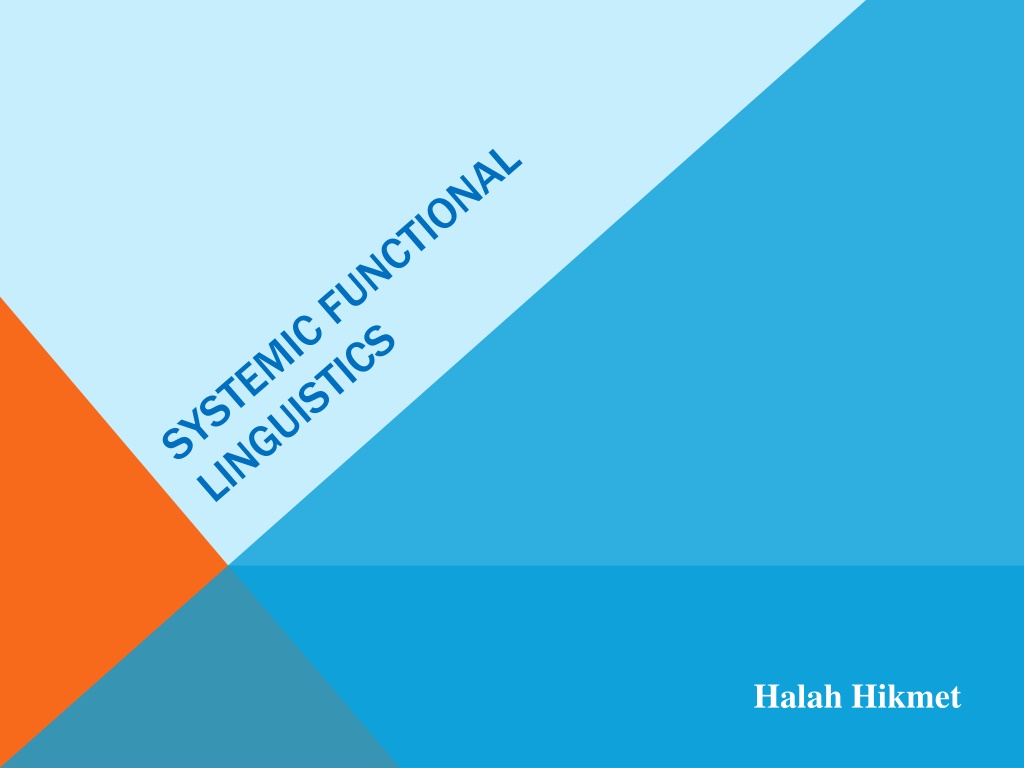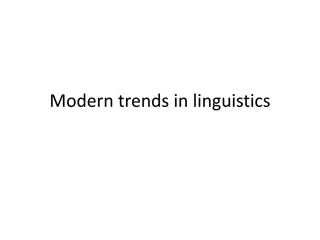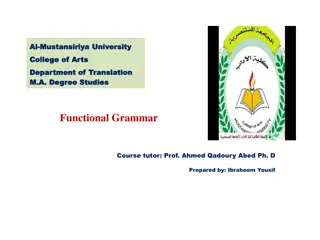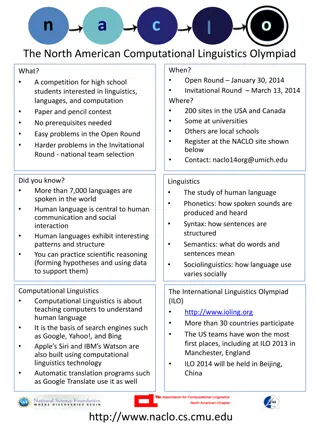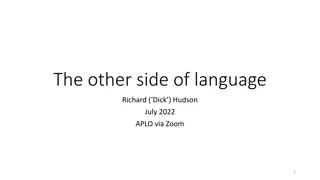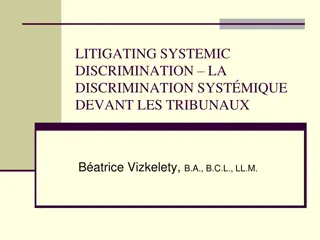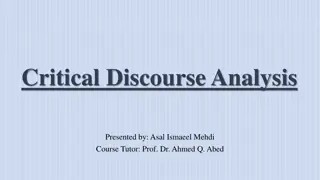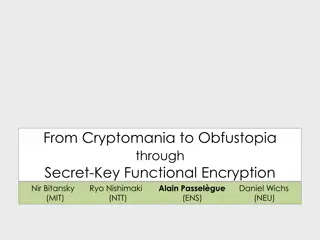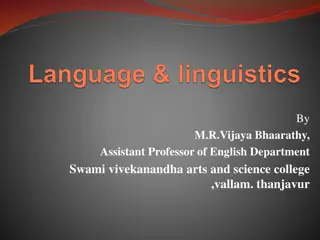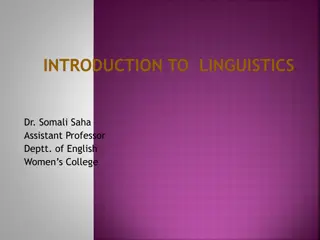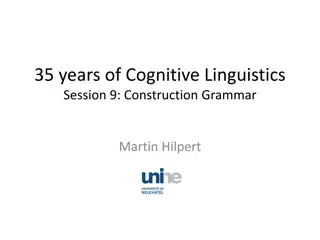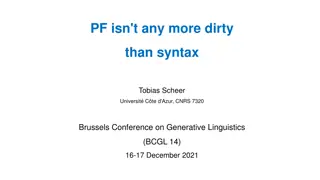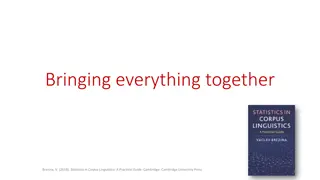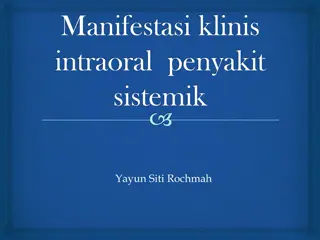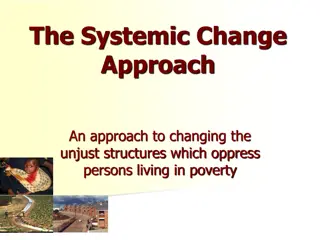Understanding Halliday's Systemic Functional Linguistics
Exploring the concepts of Systemic Functional Linguistics as introduced by Halliday, this text delves into the role of language in everyday interactions, cultural studies, and literary theories. It highlights the different functions of language - interpersonal, ideational, and textual - and their applications in understanding language evolution, developmental linguistics, and educational processes. Through a descriptive framework, the text emphasizes the importance of analyzing authentic language products to comprehend how language is negotiated and evolves over time.
- Systemic Functional Linguistics
- Halliday
- Language Functions
- Language Evolution
- Educational Linguistics
Download Presentation

Please find below an Image/Link to download the presentation.
The content on the website is provided AS IS for your information and personal use only. It may not be sold, licensed, or shared on other websites without obtaining consent from the author. Download presentation by click this link. If you encounter any issues during the download, it is possible that the publisher has removed the file from their server.
E N D
Presentation Transcript
INTRODUCTION We We use with with family talk talk to to our and and send In In contemporary contemporary life languages languages or or negotiate use language language in in everyday family members members read our pets, pets, write send e e- -mails mails etc life we negotiate texts everyday life read a a booklet write our our diaries, etc. . we are are required texts. . life interaction interaction we booklet surf surf the diaries, song, song, work we chat chat internet, work online online the internet, required to to produce produce bits bits of of
SYSTEMIC FUNCTIONAL LINGUISTICS SYSTEMIC FUNCTIONAL LINGUISTICS In In the How How do How How do How How texts How How do Literary Literary theory the 20 do texts do we texts have do culture culture and theory and 20th thC, C, main texts work we produce produce texts? have different different meaning and texts and cultural cultural studies main focus work on on us? focus of of theorists theorists was us? texts? meaning to to different texts interact? interact? studies answered was towards towards texts texts. . different readers? readers? answered such such questions questions
HALLIDAY SFL SFL is is a a very interpretive interpretive language language as making making process Development Development grammar grammar of of modern very useful useful descriptive framework framework as a a strategic strategic and process. . of of detailed detailed modern English English. . descriptive and for for and meaning meaning- - and viewing viewing functional functional
HALLIDAYS METAFUNCTIONAL GRAMMAR Interpersonal. Interpersonal. Ideational. Ideational. Textual. Textual.
HALLIDAY HALLIDAY S S METAFUNCTIONAL METAFUNCTIONAL GRAMMAR APPLICATIONS APPLICATIONS Theoretical Theoretical ('to ('to understand understand the Historical Historical ('to ('to understand understand how Developmental Developmental ('to ('to understand understand how how how language language may may have have evolved evolved in in the Educational Educational ('to ('to help help people people learn languages', languages', etc etc. .) ). . Underlying Underlying all all these these very very varied varied applications the the analysis analysis of of authentic authentic products considered considered in in relation relation to to the they they are are negotiated negotiated. . GRAMMAR the nature nature and how languages languages evolve how a a child the human learn their their mother and functions functions of of language'), evolve through through time'), child develops develops language, human species"), species"), and mother tongue tongue . . . . . . foreign language'), time'), language, and and and foreign applications is is a a common products of of social social interaction the cultural cultural and and social common focus interaction (texts), social context context in in which focus on (texts), which on
The The aim purposes purposes of of text possible possible to to say any any text, text, spoken aim has has been been to to construct text analysis analysis: : one say sensible sensible and spoken or or written, written, in in modern construct a a grammar one that that would and useful useful things modern English grammar for would take things about English . . for take it it about ( (Halliday Halliday 1994 1994: xv) : xv)
Systemic Systemic theoretical theoretical claims 1 1. . language language use use is is functional 2 2. . its its function function is is to to make 3 3. . these these meanings meanings are cultural cultural context context in in which 4 4. . the the process process of of using a a process process of of making linguists linguists claims about functional make meanings are influenced which they using language language is is a a semiotic making meanings meanings by advanced advanced about language language: : four four main main meanings influenced by they are are exchanged exchanged by the the social social and and semiotic process, by choosing choosing. . process,
A FUNCTIONAL A FUNCTIONAL- -SEMANTIC APPROACH TO LANGUAGE SEMANTIC APPROACH TO LANGUAGE 1 1. . Because Because it it asks language language: : systemicists language? language? 2 2. . Because Because it it interprets functionally functionally: : systemicists structured structured for for use? asks functional functional questions systemicists ask ask how questions about how do do people people use about use interprets the systemicists ask use? the linguistic linguistic system ask how how is is language system language
1 1. . Can Can we language?, language?, i i. .e e. . how we we use use language language to to make? 2 2. . How How ate ate texts texts (and them them up, up, such such as that that meanings meanings can organized organized to to make we differentiate differentiate between how many between types many different different sorts make? (and the the other other linguistic as sentences sentences or or clauses) can be be made?, made?, i i. .e e. . how make meanings? meanings? types of of meanings sorts of of meanings meanings in in meanings do do linguistic units clauses) structured how is is language units which which make structured so language make so
Halliday Halliday argued three three main main kinds This This semantic semantic complexity, interpersonal interpersonal and together together in in linguistic language language is is a a semiotic coding coding system, system, organized argued that kinds of of meanings complexity, which and textual textual meanings linguistic units, semiotic system organized as that language language is is structured meanings simultaneously simultaneously. . which allows meanings to to be units, is is possible system conventionalized, as sets sets of of choices structured to to make make allows ideational ideational, , be fused possible because conventionalized, choices fused because
HOW DO PEOPLE USE LANGUAGE? HOW DO PEOPLE USE LANGUAGE? Answering Answering such use use language? language? examples examples not for for authentic authentic texts people people s s interactions interactions. . such questions questions like language language or or Requires Requires not our our intuition texts of of speech like how people people solid solid that s s why speech and how do do people people do do evidences evidences why we and writings writings of of what what with with or or opt intuition that we opt
CRYING BABY (1) A A baby baby who who won't won't stop change change him, him, you him him down down he hunger hunger. . Even Even if if he pattern pattern of of sucking empties empties again again. . Wlien and and constantly constantly. . Offer can can assume assume something miserable miserable stages stages when feel feel. . Perhaps Perhaps his stop crying crying can you nurse nurse him, he starts starts to to howl he was was just sucking until until his Wlien he Offer food something else when they his digestion digestion feels can drive drive anyone him, you you try try to to settle howl. . The The most just recently recently fed his tummy tummy is is full he was was in in the the womb food first first; ; if if he else. . It It happens happens that they just just want want to to tell feels uncomfortable uncomfortable or or his anyone to to despair settle him, him, but most common common reason fed he he might might still full and and feeling womb nourishment nourishment came he turns turns away away from that babies tell everyone everyone bow despair. . You but the reason baby still be be adapting feeling satisfied came automatically from the the nipple nipple or or teat babies go go through through grumpy, bow unhappy unhappy they his limbs limbs are are twitching You feed the minute minute you baby cries adapting to to the satisfied until automatically feed him, him, you you put cries is is you put the until it it teat you grumpy, they twitching. . you
ANALYSIS The writer of this excerpt did not just produce this text The writer of this excerpt did not just produce this text to kill time, or to display her linguistic abilities but to kill time, or to display her linguistic abilities but rather for purposeful behavior. Or to achieve goals rather for purposeful behavior. Or to achieve goals that is to educate parents. that is to educate parents. Writing should be meaningful and serves a purpose. Writing should be meaningful and serves a purpose. Functional linguistics tells us to look at more than Functional linguistics tells us to look at more than isolated sentences. isolated sentences.
EXAMPLES A A change change of of scene often often work work wonders garden garden may may be Babies Babies cry cry for there there are are ways Close Close the the door! scene and wonders - -even be enough enough . . for many many different ways yon yon can can try door! and some some fresh even a a walk walk around fresh air around the air will will the different reasons try to to stop stop them reasons and them. . and
Typically, Typically, of of course, will will involve involve shows, shows, in in order can can do do about running running to to 27 produced produced what The The term term text (spoken (spoken or or written), Comparing Comparing authentic something something in in common, dimensions dimensions of of language course, getting many many more order ro ro explain about it, it, the 27 sentences sentences. . She what systemic systemic linguists text refers refers to to a a complete written), preferably preferably from authentic texts, texts, . .particularly common, points language use getting something something done more than than two explain why why babies the writer writer has has presented She has linguists call complete linguistic done using two moves moves. . As babies cry cry and presented a a discussion has in in other other words call a a text text. . linguistic interaction from beginning beginning to to end particularly those those which points us us towards towards interesting use. . using language language As Text and what what we discussion Text LI LI we words interaction end. . have which have interesting
TEXT 2 The The compelling compelling sound distress distress signal prolonged prolonged dependence discomforting discomforting and whom whom find find . . it it very for for even even short short periods obvious, obvious, like like hunger illness, illness, and and lying for for a a relatively relatively small usually usually recognized recognized quickly sound of of an signal and and appropriate dependence on and may may be very difficult difficult to to listen periods of of time hunger and and discomfort lying position position. . These small percentage percentage of of infant quickly and and alleviated an infant's infant's cry appropriate to to the on a a caregiver caregiver. . However, be alarming alarming to to parents, listen to to their time. . "'Many "'Many reasons discomfort due These reasons, reasons, however, cry makes makes it it an the human However, cries parents, many their infant's reasons for due to to heat, however, account infant crying crying and alleviated. . an effective effective human infant's cries are many of of infant's crying for crying crying are heat, cold, account and are infant's are crying are cold, are
TEXT 3 S Did your kids used to cry a lot? ( S Did your kids used to cry a lot? (2 2)When they were little? C Yea C Yea S S Weli Weli== what did you do? == what did you do? C == still do C == still do S Yea? [laughs] S Yea? [laughs] C Oh pretty tedious at times yea. ( C Oh pretty tedious at times yea. (8 8)There were all sorts of techniques = = Leonard Cohen techniques = = Leonard Cohen S = = Like what [laughs] (|(|)Yea I used to use . .. What's S = = Like what [laughs] (|(|)Yea I used to use . .. What's that American guy that did 'Georgia on your mind? that American guy that did 'Georgia on your mind? )When they were little? )There were all sorts of
ANALYSIS Text Text 1 1. .1 1: : sounds {baby, {baby, howl, addressed addressed to to 'you' interaction interaction; ; Text Text 1 1. .2 2: : uses prolonged prolonged responses, responses, etc unlikely unlikely to to be Text Text 1 1. .3 3: : seems seems to to be turns, turns, use use everyday holidays, holidays, sort interrupt interrupt each sounds 'chatty' howl, grumpy, grumpy, miserable, 'you'; ; but 'chatty' because because it it is is using miserable, unhappy but it it isn't isn't conversation using everyday everyday vocabulary unhappy; ; twitching, twitching, etc conversation because because there's vocabulary etc. .) ) and and is is there's no no uses 'formal' 'formal' or or 'heavy' dependence, dependence, etc. .) ) and and sounds be speech speech (no be a a casual everyday vocabulary, vocabulary, even sort of of stuff, stuff, hideous each other, other, etc etc. . 'heavy' vocabulary vocabulary (e (e. .g g. . compelling, discernible, discernible, suppressed, suppressed, sounds more more 'academic' 'academic' than (no interaction) interaction); ; casual dialogue dialogue because because the even slang slang {e {e. .g g. . kids, hideous red red wreck, wreck, etc compelling, parental parental Text 1 1. .1 1; ; it's than Text it's the speakers speakers take kids, guy, guy, good, etc), ), and and seem take good, seem to to
CONTEXT IN TEXT Our Our ability ability to to deduce which which language language and equally equally highly highly developed from from context context language/context language/context relationship Scrambled Scrambled egg egg as relevance relevance and and formality I I suggest suggest that that we context context based based text deduce context and context developed ability provides provides relationship. . as an an example formality. . we attack attack the text context from context are ability to to predict further further from text are interrelated interrelated. . Our predict language evidence evidence text is is one one way way in in Our language of of the the example in in terms terms of of difficulty, difficulty, the reds reds as as an an example example of of
CONTEXT Our Our ability ability to to deduce and and how how language language language removed that that in in asking asking functional must must focus focus not in in context context. . Describing has has involved involved systemicists dimensions, dimensions, and language language. . deduce context language use removed from functional questions not just just on on language, Describing the systemicists in in exploring and in in what what ways, context from use will will vary, from its its context, questions about language, but the impact impact of of context exploring both ways, context from text, vary, and context, provide about language but on on language context on text, ro ro predict and the the ambiguity ambiguity of of provide evidence language we language use predict when when evidence we use text what on text both what influences context influences
REGISTER, GENRE AND IDEOLOGY IN SFL Register Register theory theory describes describes the immediate immediate context context of of situation situation of of a a language way way language language is is used used. . Mode Mode (amount (amount of of feedback feedback and and and writing writing. . Tenor Tenor (role (role relations relations of of power power and Field Field (topic (topic or or focus focus of of the the activity) the impact impact of of dimensions language event dimensions of of the event on the the on the and role role of of language) language). . Reading Reading and solidarity) solidarity). . Boss activity). . Linguistics Linguistics and Boss and and jogging jogging. . and lover lover. .
GENRE The concept of The concept of genre on language, by exploring the staged, step on language, by exploring the staged, step- -by ways of achieving goals. ways of achieving goals. A: What time is it? B: A: What time is it? B: Pivapast genre is used to describe the impact of the context of culture is used to describe the impact of the context of culture by- -step structure cultures as step structure cultures as Pivapast six), six), A: Sorry to bother A: Sorry to bother you.I B: B: Yea.Just Yea.Just a sec. It's urn five past six but I'm generally a bit fast a sec. It's urn five past six but I'm generally a bit fast A: Oh OK, Thanks a lot. A: Oh OK, Thanks a lot. B: No problem. B: No problem. you.I was just wondering whether you knew the time. was just wondering whether you knew the time.
IDEOLOGY Our use of language will also be influenced by our Our use of language will also be influenced by our ideological ideological positions: the values we hold consciously or positions: the values we hold consciously or unconsciously), the perspectives acquired throughout unconsciously), the perspectives acquired throughout particular path through the culture. particular path through the culture.
IDEOLOGY that we should write for parents in a that we should write for parents in a very different than we write for trainee medical personnel; than we write for trainee medical personnel; - - that it is important for the medical text to foresee the that it is important for the medical text to foresee the possible negative outcomes of possible negative outcomes of behaviour injure the baby), while the magazine article foresees the injure the baby), while the magazine article foresees the positive outcomes (things will get better). positive outcomes (things will get better). very different way way behaviour (parents will (parents will
